Peripatric speciation occurs when a small population becomes isolated at the edge of a larger one, leading to the emergence of new species due to genetic drift and selection pressures. This process often results in rapid evolutionary changes driven by limited gene flow and unique environmental conditions. Explore the rest of the article to understand how peripatric speciation shapes biodiversity and impacts your perspective on evolutionary biology.
Table of Comparison
| Aspect | Peripatric Speciation | Sympatric Speciation |
|---|---|---|
| Definition | Speciation in isolated peripheral populations | Speciation within the same geographic area |
| Geographic Context | Small peripheral isolates at range edge | Overlapping or identical ranges |
| Gene Flow | Limited or no gene flow due to isolation | Potential gene flow; reproductive isolation evolves |
| Population Size | Small, founder effect common | Large, sympatric population |
| Mechanism | Genetic drift, selection in isolation | Disruptive selection, polyploidy, assortative mating |
| Example | Island species divergence | Cichlid fish in African lakes |
| Speciation Speed | Typically faster due to isolation | Varies; can be rapid via chromosomal changes |
Introduction to Speciation
Peripatric speciation occurs when small populations become isolated at the edges of a larger population's range, leading to rapid genetic divergence due to limited gene flow and genetic drift. Sympatric speciation happens within a shared geographic area through mechanisms like polyploidy, sexual selection, or ecological niche differentiation, promoting reproductive isolation without physical separation. Both processes are critical in understanding how species diverge and adapt through evolutionary pressures in distinct environmental contexts.
Defining Peripatric Speciation
Peripatric speciation occurs when a small population becomes geographically isolated at the edge of the larger parent population's range, leading to rapid genetic divergence due to founder effects and genetic drift. This mode of speciation is characterized by the isolation of peripheral populations in distinct habitats, which facilitates reproductive isolation over time. Unlike sympatric speciation, which happens within overlapping ranges, peripatric speciation relies predominantly on geographic separation and population size reduction to drive evolutionary change.
Understanding Sympatric Speciation
Sympatric speciation occurs when new species evolve from a single ancestral population while inhabiting the same geographic region, driven primarily by genetic mutations, ecological niches, or behavioral shifts that reduce gene flow. Unlike peripatric speciation, which involves small isolated populations on the periphery, sympatric speciation relies heavily on reproductive isolation mechanisms such as polyploidy in plants or assortative mating in animals. Key examples include cichlid fishes in African lakes and apple maggot flies, where disruptive selection facilitates divergence without physical barriers.
Key Differences Between Peripatric and Sympatric
Peripatric speciation occurs when a small isolated population at the edge of a larger one diverges genetically due to geographic isolation, while sympatric speciation happens within a single population without physical barriers through mechanisms like polyploidy or niche differentiation. Gene flow is typically interrupted in peripatric speciation, leading to rapid divergence driven by genetic drift and selection, whereas sympatric speciation maintains gene flow to some extent, relying more on ecological or behavioral isolation. The primary difference lies in the spatial context: peripatric involves geographic isolation, whereas sympatric occurs within the same geographic area.
Geographic Isolation in Peripatric Speciation
Peripatric speciation primarily occurs through geographic isolation, where a small population becomes physically separated at the periphery of the main population's range, leading to reduced gene flow and increased genetic drift. This isolation allows distinct evolutionary paths due to unique selective pressures and random mutations in the peripheral population. In contrast, sympatric speciation arises without geographic barriers, typically through ecological or behavioral divergence within the same habitat.
Ecological Factors in Sympatric Speciation
Sympatric speciation is driven by ecological factors such as resource partitioning and niche differentiation within the same geographic area, allowing populations to exploit different habitats or food sources. This ecological divergence reduces gene flow between groups by favoring adaptations to distinct environmental conditions. Unlike peripatric speciation, which involves geographic isolation, sympatric speciation relies heavily on ecological specialization and selective pressures maintaining reproductive isolation.
Genetic Drift and Founder Effect in Peripatric
Peripatric speciation involves a small population becoming isolated at the edge of a larger population's range, where genetic drift and the founder effect play crucial roles in accelerating genetic divergence. Genetic drift causes random fluctuations in allele frequencies within the small, isolated group, significantly impacting its genetic makeup compared to the original population. The founder effect occurs as the new population descends from a limited number of individuals, reducing genetic diversity and enhancing differentiation essential for speciation.
Role of Natural Selection in Sympatric Speciation
Natural selection drives sympatric speciation by favoring genetic variants that exploit distinct ecological niches within the same geographic area, leading to reproductive isolation without physical barriers. In contrast to peripatric speciation, where isolation is often due to geographic separation of small populations, sympatric speciation relies on disruptive selection and assortative mating to reduce gene flow among diverging groups. This process promotes divergence through adaptation to different environmental resources or behaviors, reinforcing speciation within an overlapping habitat.
Real-World Examples of Peripatric and Sympatric Speciation
Peripatric speciation occurs when small populations become isolated at the edge of a larger population's range, exemplified by Darwin's finches on the Galapagos Islands, where geographic isolation led to distinct species. Sympatric speciation happens within a shared habitat through genetic divergence without physical barriers, as seen in apple maggot flies (Rhagoletis pomonella) that diverged from hawthorn-feeding populations by shifting to apples. Both modes demonstrate how speciation can result from reproductive isolation driven by ecological factors or geographic separation.
Implications for Biodiversity and Evolution
Peripatric speciation, occurring in isolated peripheral populations with limited gene flow, promotes rapid genetic divergence and fosters the emergence of unique species, significantly enhancing biodiversity. Sympatric speciation, driven by ecological niche differentiation and genetic polymorphism within overlapping populations, contributes to biodiversity by enabling species diversification without geographical barriers. Both mechanisms influence evolutionary trajectories by shaping adaptive radiations and impacting genetic variability, crucial for ecosystem resilience and long-term species survival.
Peripatric Infographic

 libterm.com
libterm.com